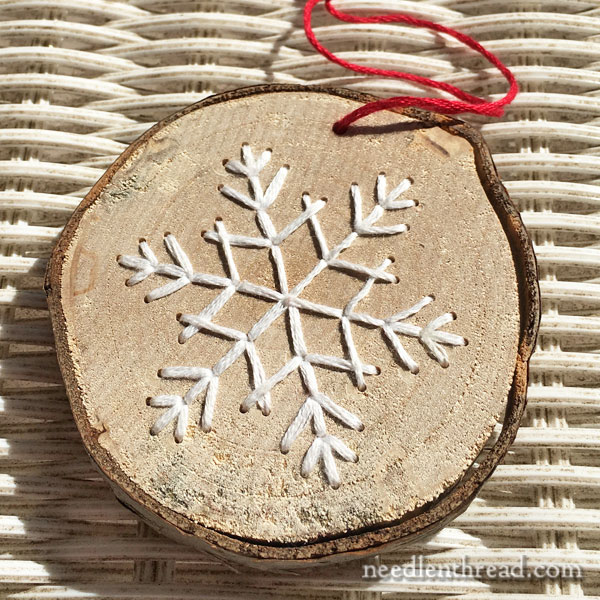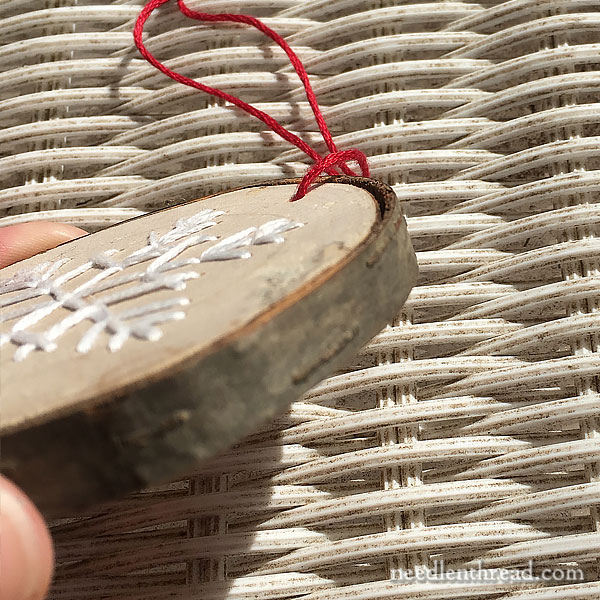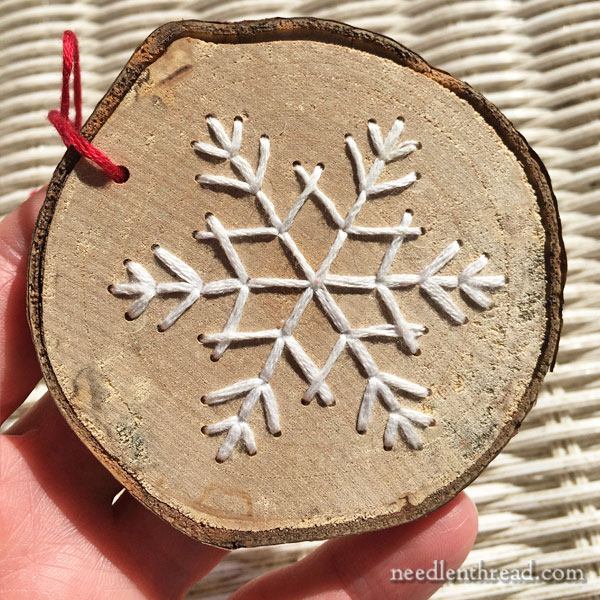Last week, my sister from Pennsylvania showed up for our family reunion, toting along a little sample project she whipped up.
It brought to mind a discussion I recently had with Gary & Christine on FiberTalk, about embroidering anything.
The question arose: when do you draw the line on whether or not to call something embroidery. Can you embroider anything, and still call it embroidery?
Since I’m a sucker for all things embroidery, I tend to learn towards yes, you can. I’d probably draw the line, though, when it leads to a confusion of concepts.
In this particular case, there’s no confusion. This is obviously embroidery, and this little example serves to demonstrate that you can definitely embroider unconventional things!

My sister Sarah hails from an area of northeastern Pennsylvania where birch trees are prevalent, and in the interest of good husbandry, their trees get a good trimming now and then. Dying trees get removed. Branches culled. New trees planted.
They actually have a sheep farm, River’s End Sheep, where my niece raises grass-fed Suffolk and Jacob breeding stock and grass-fed lamb. So if you’re in the area, looking for sheep for 4-H or for maybe to start your own woolery, they’re a good source!
In any case, besotted with her collection of birch logs, my sister got it into her head that she could slice the round logs down into disks, to do something with.
From there, it was not much of a leap to think of Christmas ornaments.
And from there, while we were FaceTiming one day, it wasn’t much of a leap to embroidery.

Birch bark, incidentally, has long been used in handicrafts, especially by Native Americans, and fashioned into containers, pouches, boxes and so forth, embellished with stitchery. So this concept of stitching on birch isn’t exactly new!
While it’s never good to remove birch bark from living trees – removal can kill the tree – the bark is amazingly resilient even after the tree is dead and can be stripped off the dead tree for use.
You can find some fantastic images of moose hair embroidery on birch bark, simply by googling “moose hair embroidery on birch bark.” This article on the Fenimore Art Museum blog talks a bit about it, and offers a few photos, too, if you want to read more about embellishing birch bark with embroidery.
So, what Sarah did was this: taking culled branches from some of her birch trees, she salvaged good, consistent ones and sawed them into half-inch disks.
The dark, inner ring of the bark was kept in place, providing a rustic frame around the disk.

Then she took a simple snowflake pattern, marked the intersections and beginnings and ends of the design lines onto the birch disk, drilled tiny holes with a dremel, and stitched the design using six strands of white floss.
She made sure the beginnings and ends of the threads were tucked into the thick wood and secured, so that you can’t tell the difference between the front and the back of the embroidery.
I think they make adorable, rustic ornaments that are much more interesting than prefab, stitchable wooden disks. I love how the birch disks preserve the rustic character of the tree!
What’s Coming Up
Exploring the wooden disks brought me back to the whole concept of embroidering eggs. And it just so happens I know someone with a fresh supply of goose eggs. The brain is whirring…
But on the more realistic front, I’ve prepped some experimental linen fabric to test it for stitching and construction possibilities, and I’ll be sharing those explorations with you.
And ooooh….I’ve received an advanced copy of a much anticipated book, too, so I’ll be reviewing it for you this week. You’ll be among the first to see the insides!
I had a terrific week last week with my family as we celebrated my parents’ 60th anniversary and played together during our reunion! It was rather a mad week! But it’s good to be back in the swing of things again, and I’m looking forward to sharing lots of exciting stitchy stuff with you in the coming weeks!







Hi Mary, your article this morning reminded me of Amy Mitten’s sampler from her Around the World series – Excursion #7 Canada. She designed a cotton fabric that gives the effect of birch bark and she uses some very exotic threads, such as “real moose, horse and elk hair”. You can see pictures and a more thorough description on her website at amymitten.com
Dear Mary
What a lovely idea embroidery on birch logs and beautifully stitched, it looks so lovely and natural, a great idea for Christmas and yes it does remind me of embroidery on eggs. There’s certainly a lot of talent in your family. I’m glad you had a great time with your family, but glad you are back and I look forward to the coming posts. Thanks for sharing your sisters embroidered birch logs with us and for the photos.
Regards Anita Simmance
Love those ornaments! I read an article in a South African magazine recently about a lady embroidering old tennis raquets! They’re spectacular and apparently introducing a new generation to embroidery.
Well, I think it’s decorating vs embroidery
Decorating a surface which could remain just fine without decorating/isn’t meant to be decorated,looking naturally good on its own… OR embroidery – an art invented to embellish textile items – like linen, which can look dull un-decorated or simply because it’s often meant to be (unlike bark…); just like variety of canvases produced specifically for embroidery
To me there is a ‘natural’ element about embroidering on fabric. Whilst embroidery on unusual surfaces just isn’t natural (and then it’s pretense. although I’m sure not in this case 😉
Mary, can you embroider anything? Check this out.
https://www.behance.net/gallery/31502957/Everyday-bread
Hi Mary! Yes, you can embroider anything, just look at this article!
http://www.ufunk.net/en/artistes/embroidered-metal/
Amazing stuff. :>)
Mary, How did you know? Last week, since you were busy, I was casting about for something small to work on. My Assisi Project uses too many brain parts and I needed a break from it. So I thought something new for the Christmas Season. I promptly downloaded a cute snowflake from your site. There’s a lot of Christmas Embroidery on your site that doesn’t show up under Christmas. I remembered a tree, and hunted till I found it. Imagine my surprise when I found the 2014 ornaments this morning. See what happens when I follow you down the rabbit hole? Now, I’m going to have to tuck one of these into my binder.
Because you were off doing family things, I decided to give my embroidery center an overhaul. My threads and beads are nicely organized, but it’s the rest of the stuff that’s out of control. I took 2 giant 3 ring binder. Using sheet protectors I loaded all my “I want to do this someday projects” into one binder. In the second binder, I organized all the projects for which I have ALL the supplies. In this case, linen and pattern, wire (stumpwork) and specialty thread/beads just for those projects. In other words, little mini kits all organized into expandable pockets.
I’m beginning the Talliaferro La Serenissima next week at the San Francisco School of Needlework and I took the opportunity to clear the decks and get everything ready for that class as well!
Whew hoo! With everything so clean and tidy, I’m ready to rock that needle. Thank your family for me.
Years ago my mother and I sat on the floor/ground on opposite sides of a sliding screen door. We embroidered grass and flowers near the bottom and center section with a sun at about eye level, passing the needle and thin yarn back and forth to each other. This was supposed to keep children and others from walking into the screen; worked almost every time.
I personally have embroidered quite a lot of plastic and tracing paper lately. I also love the work of Bella Leonard who embroiders perspex: http://www.textileartist.org/bella-may-leonard-interview-sculptural-embroidery/
I agree with you. You can use embroidery stitches on almost any background and it is still embroidery, even if not traditional.
This reminds me of the crafts my Aunt used to do with birch bark and porcupine quills. I don’t think you could call it embroidery, since it was quills and not lengths of thread, but it was a very similar concept.
I guess creativity does run in the family. I just love these ornaments.